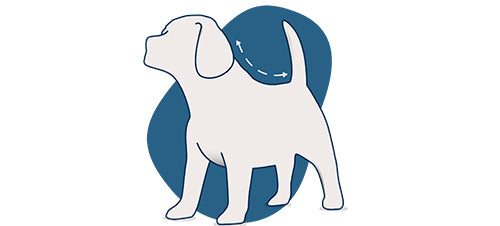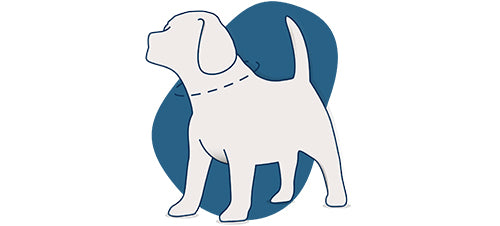Are you obsessed with endlessly scrolling through adorable puppy videos on TikTok and Instagram? So are we!
In our most recent study, we took a deep dive into the world of pet influencers, estimating which furry stars are raking in the most money and how you can get in on the action.
When identifying four-legged social media sensations, we conducted extensive research to identify the most popular pet accounts across Instagram and TikTok. We estimated their potential earnings per post and compiled a list of the wealthiest pet influencers.
But we didn’t stop there – by analysing top pet profiles and speaking to Raé MB, owner of pet social media star, Mochi (@mochi.bostiegirl), we have provided some expert insight into what makes a profitable pet account, how to maximise your earnings, and the benefits of maintaining a social media presence for your pet.
The Highest Earning Dog Influencers in the UK and USA

In the pet influencer space, some dogs are truly living the dream, earning impressive incomes from their social media stardom.
From the UK to the USA, these top canine influencers are fetching the big bucks and winning hearts across the globe.
By analysing their follower counts, estimating earnings per post and tallying up their branded content in the past 12 months, we've uncovered the highest-earning dog influencers and reveal just how successful their careers can be.
The UK's leading pets, making waves on social media:
1. @BlueStaffyBoulder – £339k (Instagram)
The research revealed the UK’s top dog influencers is @BlueStaffyBoulder. With around 205k followers on Instagram, it turns out this pet star could be earning over £339,000 yearly! We estimated that Boulder and Harley could be earning around 3k per post from with their 113 branded uploads in the past year. That said, this blue Staffy has made it into the top 1% of highest earners in the country, according to Institute of Fiscal Studies.
2. @GSDBear – £90k (Instagram)
Coming in second is the fabulous German Shepherd dog model, @GSDBear, who could be earning up to £90k a year. This talented furball featured 18 branded posts this year and makes an estimated £5k per post – light work!
3. @My_Blue_Wolf – £10.5k (Instagram)
Third place goes to Ocean, the dazzling Blue Wolf Dog taking Instagram by storm. With 456k followers on Instagram and estimated earnings of £5k per post, this canine sensation could be pocketing around £10.5k a year.
4. @DigitDax – £22.5k (Instagram)
Following suit, Miniature Dachshund duo Digit and Pippa could be taking home £22,500 per year from their Instagram presence. With 9 branded posts in the past 12 months, the pair are making an estimated £2.5k per post.
5. @Lecorgi – £10.5k (Instagram)
Coming in fifth on our list of highest-earning UK dog influencers is Marcel Le Corgi, a London-based volunteer therapy dog. Marcel certainly lives the high life, traveling the world, sampling new foods, and earning an estimated £10,500 annually from his popular Instagram account. With 140k followers, Marcel could be making around £1,500 per post, having shared only 7 branded posts in the past year.
Across the pond, the pups making the most income in the US are:
1. @WhatAboutBunny – £630k (Tiktok)
Our research uncovered that the top-earning US pet influencer is @WhatAboutBunny, a renowned Sheepadoodle boasting an impressive 8.6M followers on TikTok. Bunny's potential earnings are staggering, estimated at £630,000 annually. Despite this substantial income, Bunny only mentioned brands in 21 posts over the past year suggesting that this star makes around £30,000 per post – truly a paw-sitively great career path!
2. @AGuyAndAGolden – £500k (Tiktok)
In second place, earning an estimated half a million pounds a year (£500,000), is @AGuyAndAGolden. With 7.5M followers on his Tiktok account, this gorgeous Golden Retriever only needed to post 20 times to earn his keep, taking home an estimated £30,000 per post.
3. @Loki – £172k (Instagram)
Third place goes to the lovely @Loki, who fetched an estimated £172,000 from his 36 branded posts in the past year. It appears Loki’s 1.9M followers are a loyal fan base, as this famous Wolf Dog boasts a high engagement rate of around 205%.
4. @DougThePug – £140k (TikTok)
Doug the Pug came in fourth, raking in an impressive estimated yearly salary of £140,000. Despite posting just 7 times in the past 12 months, this cheeky pup could earn around £20,000 per post. Doug is one wealthy “good boy” who barely has to lift a paw – talk about living the high life with minimal effort!
5. @LadyAndTheBlues – £70k (TikTok)
Wrapping up our top five highest-earning US pooches is Lady, a Golden Retriever social media sensation. Our research suggests this clever canine could be pocketing around £70,000 annually, with each post potentially earning her £10,000. Like Doug the Pug, Lady enjoys a pretty laid-back lifestyle, having posted just 7 branded content pieces in the past year.
How Do I Navigate My Way to Pet Social Media Stardom?


To learn more about what it takes to run a successful pet social media account, we chatted with Raé MB, the owner of @mochi.bostiegirl, who has built a community of over 6K followers on Instagram.
Raé shared her expert insights on building a community for your dog, collaborating with brands, and some of the challenges she's faced along her pet influencing journey.
Best Ways to Build Followers and Create an Online Community
“Being authentic, creating shareable content, engaging with similar breeds as a start, and then branching into different breeds and leaving meaningful comments. This is very time-consuming though - but it’s important to build an actual community.
“Find your niche! For example, we are a dog-friendly travel and lifestyle account – so we share tips on travel, dog-friendly places and dog fashion. We also collaborate with bigger dog-friendly travel accounts which also helps us reach and find like-minded pet parents who want to look for places they can take their dog to - for holidays, days out and just to eat!
“It’s also important to ‘show up’ on socials - people LOVE knowing your day-to-day whether that’s in the form of captions or on stories. This is a great way to connect with your audience by sharing what might seem quite mundane but is very relatable.”
How to Know When You’re Ready to Work with Brands
“Because Mochi was still a puppy (1 year old) when we started, we used social media to find out info that helped her development like training tips and advice on feeding.
“We also started following brands and found a plethora of businesses that specialise in creating wonderful harnesses and even personalised dog leads and fashion borg jumpers and functional but stylish fleeces! Once I started to buy from them, and post Mochi wearing their items, brands started to engage with us and look for ambassadors to promote their products in exchange for personal discount and gifting sometimes.
“I find, as there’s so many dog accessory brands, food brands and fashion brands, the best thing to do is showcase your skills in photography and reels, showcasing how you’d market their product. Some brands aren’t too particular about follower count and factor in engagement metrics rather than vanity metrics. On dog Instagram, brands often have ambassador searches, and entering these would be beneficial to start working with brands.
However, it’s important to note that you should pick brands you authentically love and want to be associated with!”
Positives and Challenges
“Challenges… it can be very toxic and just like any influencer in any niche - people can be competitive and very unkind.
“But the positives are meeting fabulous likeminded people - whether it’s pet parents who love to travel with their pets, love fashion or trick training.
“It does feel like you have a support system too, if for example, you’re struggling with a poorly pet or a reactive, anxious dog. I’ve found lots of dog mums who have introduced me to wonderful dog trainers and given me tips on how to train a behaviour with my dog.
“I have made a small but lovely group of forever friends from dog social media!”
Expert Tips on Getting Your Profile Started, From the Experts
Alongside expert dog influencer insight, our team of pet experts have also provided some essential advice on how to get started with your pet’s social media account; from crafting your profile, to keeping audiences engaged:
1. Finding Your Perfect Co-Star
“It all starts with the right pet! Choose a companion you adore and can provide a loving home for.
“Research local regulations and consider breeds that thrive in your climate and living situation. Remember, a happy and healthy pet is the foundation for a successful online presence.”
2. Crafting Your Profile
“First impressions are key, so be sure to craft a bio that clearly explains your content and shows off your pet's unique personality.
“Decide if you'll create a dedicated pet profile or a joint account. Different platforms cater to different audiences, so choose the one that best suits your content and target demographic (e.g. posting puppy playdates on Instagram versus informative training tips on YouTube).”
3. Content is Key
“High-quality photos and videos are a must – capturing your pet's adventures, funny antics, and heartwarming moments.
“Be sure to post consistently and interact with your followers in the comments to build your community. Additionally, it’s a good idea to utilise features like live streaming for real-time engagement and write eye-catching captions with relevant hashtags to improve your chances of being discovered.”
4. Expanding Your Pawprint
“Growing your audience requires consistent effort, which can be accelerated by connecting with other pet influencers to tap into their followers.
“And don't be shy about reaching out directly to brands you love! Collaboration is key - explore partnerships with other pet influencers for broader exposure.”
5. Remember: This is a Marathon, not a Sprint!
“The key to growing your pet’s online community is staying active and consistent with your posting schedule.
“Pay close attention to your analytics to understand what resonates with your audience, ensuring to refine your strategy accordingly.
“And of course, keep exploring new content formats and collaborations to keep your followers engaged and expand your influence in the exciting world of pet social media.”
Conclusion
Our exploration of the pet influencer world has revealed the furry stars that are not only melting hearts, but also generating impressive incomes through their social media prowess. From the UK to the USA, these top canine influencers demonstrate that cuteness truly can lead to substantial rewards!
And whether you're just starting your pet's social media journey or refining your current approach, we hope that our expert tips on building a successful pet profile and collaborating with brands provide valuable insights.
If you’re looking to glam your dog up for the ‘gram, why not check out our range of stylish dog coats, where there’s something to fit every pup’s aesthetic.
Sources and Methodology
Top Dog Influencers:
https://thesocialshepherd.com/blog/top-pet-influencers-uk
https://www.theguardian.com/media/2023/jan/20/meet-hugo-and-huxley-the-pet-influencers-makingt-100k-a-year
https://www.companionlife.co.uk/new-data-reveals-the-highest-earning-dog-fluencers-in-2023-with-instagram-taking-top-spot-over-tiktok/
https://influencers.feedspot.com/dog_instagram_influencers/
https://www.dogingtonpost.com/10-richest-dogs-on-instagr
https://hypeauditor.com/instagram/harlowandsage/
https://finance.yahoo.com/news/millionaire-pets-highest-earning-pets-200027940.html
https://ifs.org.uk/tools_and_resources/where_do_you_fit_in#tool-results-section
Estimated price per post calculations:
https://influencermatchmaker.co.uk/how-much-does-an-influencer-cost
https://www.shopify.com/uk/blog/influencer-pricing







































































.jpg?v=1725444478725&options=)
.jpg?v=1725440760488&options=)
.jpg?v=1724921468464&options=)
.jpg?v=1724239408735&options=)






























